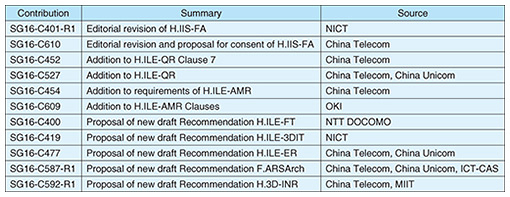 |
|||
|
|
|||
|
Global Standardization Activities Vol. 22, No. 9, pp. 93–96, Sept. 2024. https://doi.org/10.53829/ntr202409gls ITU-T SG16 Meeting ReportAbstractThe International Telecommunication Union - Telecommunication Standardization Sector (ITU-T) Study Group 16 (SG16) meeting was held in Rennes, France, in April 2024 with online participation (hybrid). NTT Group made a proposal to Question 8 to initiate a new work item on °»first-person transfer immersive live experience,°… which enables users to share (feel) the sensation of the performer at a remote event site (e.g. the piano player in a music concert). This article mainly reports on the discussion and result of Question 8. Keywords: ITU-T, first-person transfer immersive live experience (FT-ILE), FEEL TECH 1. ITU-T SG16 meeting, April 2024, Rennes, FranceThe International Telecommunication Union - Telecommunication Standardization Sector (ITU-T) Study Group 16 (SG16) meeting was held 15–26 April 2024 in Rennes, France with remote participation (hybrid). The author participated in the meeting online as an associate rapporteur for Question 8 (Q8) of Working Party 3 (WP3). Tables 1 and 2 show the management team of Q8 and the list of Contributions to Q8, respectively. Among the 11 Contributions, 6 were additions and revisions to the existing draft Recommendations, and 5 were proposals to initiate new work items. The discussion and results are described below with emphasis on the proposal from NTT Group to initiate a new work item on first-person transfer immersive live experience (FT-ILE).
2. Discussion summary and results of ITU-T SG16 Q8 meeting2.1 Proposal of draft Recommendation H.ILE-FT (SG16-C400)A proposal to initiate a new draft Recommendation (H.ILE-FT: An architectural framework for FT-ILE) was submitted to internationally standardize NTT DOCOMO’s FEEL TECH technology [1]. The Contribution proposed to describe the requirements, functional components, and architectural framework of FT-ILE in the draft Recommendation. “First-person ILE” is first proposed in the Contribution. This is a new type of ILE in which the audience can experience first-person sensation. At a piano concert, for example, a remote user can experience vision, sound, haptic sensation, etc. of the actual piano player. In the conventional ILE, a remote user can experience the piano concert as if they were among the audience at the concert venue. This can be called third-person ILE. Figures 1 and 2 show the conventional third-person ILE and proposed first-person ILE, respectively.
In the example of transmission of haptic sensation of a pianist, a remote user can experience the pianist’s haptic sensation at the tip of their fingers. The sensation can differ from person to person, affected by their sensitivity to stimulation, the size of their hands, etc. Therefore, data and processing to adjust such differences are necessary. First-person ILE uses data that are more closely related to the pianist and the users than the conventional third-person ILE, necessitating a different architecture. With those considerations as a background, a new draft Recommendation was proposed. The proposal was discussed at the meeting, and the initiation was agreed with comments. Support of the initiation was offered from KT (formerly, Korea Telecom), National Institute of Information and Communications Technology (NICT), and China Telecom during the meeting in addition to the source of the Contribution, NTT DOCOMO and NTT. Ms. Nishio (NTT DOCOMO) was appointed as an editor along with one from China Telecom. 2.2 Proposal of H.ILE-3DIT (SG16-C419)Initiation of a new draft Recommendation H.ILE-3DIT (Functional requirements and frameworks of three-dimensional (3D) model-based immersive telepresence system) was proposed by NICT. It proposes to clarify the functional requirements and frameworks of a 3D model-based immersive telepresence system in which a 3D model of each remote participant is constructed from image information and displayed in real time at appropriate locations with appropriate posture in a shared 3D space. This is in line with an ILE service scenario of a remote meeting described in ITU-T Recommendation H.430.3 (ILE service scenario). The initiation was agreed. 2.3 Other proposals and discussion resultsOKI and NICT contributed proposals to revise the existing draft Recommendations H.IIS-FA (Functional architecture of interactive immersive services system) and H.ILE-AMR (Framework of ILE using multiple autonomous multimedia-enhanced mobile robots), respectively. These were agreed after discussion. China Telecom and others proposed initiation of three new draft Recommendations. Two (SG16-C587-R1, SG16-C592-R1) were agreed with revisions to their titles (H.ILE-AR, H.ILE-3DINR). The other was related to Q26 of SG16. After consultation with Q26, it was agreed to continue collaboration with Q26, and the initiation was postponed. H.IIS-FA was consented. Other revision proposals to the existing draft Recommendations were discussed and agreed. 3. ConclusionsNew draft Recommendation H.ILE-FT, which aims for international standardization of NTT DOCOMO’s FEEL TECH technology, was initiated. NTT will collaborate with NTT DOCOMO to enrich the draft Recommendation. The current study period of ITU-T is in its final year. This means the World Telecommunication Standardization Assembly (WTSA), ITU-T’s highest decision-making body, will be held (this time in India in October 2024). It will be the first WTSA for the current Director of the ITU Telecommunication Standardization Bureau, Mr. Onoe, a former NTT executive. NTT will collaborate with ITU-T further for a successful WTSA. Reference
|
|||





